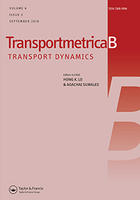
Transportmetrica B-Transport Dynamics
Scope & Guideline
Advancing Knowledge in Transportation Dynamics
Introduction
Aims and Scopes
- Traffic Flow Dynamics:
Research on the behaviors and interactions of vehicles in different traffic scenarios, including the study of car-following models, traffic congestion, and dynamic traffic assignments. - Modeling and Simulation:
Utilization of advanced modeling techniques and simulation frameworks to analyze transportation systems, including multi-agent models and deep learning approaches for predicting traffic patterns. - Public Transportation Systems:
Exploration of public transport dynamics, including optimization of routes, scheduling, and demand-responsive transit systems to improve service efficiency and user experiences. - Safety and Risk Assessment:
Investigation of safety dynamics in transportation networks, focusing on crash risk prediction, traffic conflict analysis, and the development of safety assessment frameworks. - Emerging Technologies in Transportation:
Analysis of the impact of connected and automated vehicles, electric vehicles, and other emerging technologies on transportation systems and dynamics. - Sustainable Transportation Solutions:
Research on environmentally-friendly practices in transportation, including optimization frameworks for road pricing, energy consumption reduction, and integration of sustainable modes of transport.
Trending and Emerging
- Data-Driven Approaches:
There is a growing emphasis on utilizing large datasets and machine learning techniques to inform transportation modeling, prediction, and optimization, showcasing a shift towards data-centric methodologies. - Connected and Automated Vehicles (CAVs):
Research on the implications and dynamics of connected and automated vehicles is on the rise, reflecting the industry's shift towards automation and the integration of smart technologies in traffic management. - Sustainable Transportation Practices:
The journal is increasingly focusing on studies that address sustainability in transportation, including electric vehicle integration, eco-driving strategies, and sustainable urban mobility solutions. - Resilience and Robustness in Transportation Systems:
Emerging themes include the resilience of transportation networks in the face of disruptions, such as natural disasters or pandemics, highlighting the need for robust planning and response strategies. - Interdisciplinary Research Approaches:
There is a trend towards interdisciplinary research combining elements from urban planning, economics, and environmental science to address complex transportation challenges comprehensively.
Declining or Waning
- Traditional Traffic Management Strategies:
There is a noticeable decline in studies centered around conventional traffic management strategies, such as fixed-time signal control, as more adaptive and data-driven approaches gain traction. - Static Demand Forecasting Models:
Research utilizing static models for demand forecasting in transportation has decreased, giving way to dynamic and machine learning-based approaches that account for real-time variability. - Non-Integrated Transportation Studies:
The focus on isolated studies that do not integrate various transportation modes or systems is waning, as the trend shifts towards more holistic and interconnected transportation research. - Human Factor Studies in Traffic:
While human factors remain important, the volume of research solely dedicated to behavioral studies in traffic settings has diminished as technology-driven analyses become more prevalent. - Basic Infrastructure Studies:
There is a decrease in publications focusing solely on basic infrastructure improvements without integrating advanced technologies or data-driven methodologies.
Similar Journals
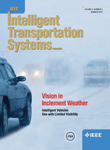
IEEE Intelligent Transportation Systems Magazine
Transforming Transportation Through InnovationIEEE Intelligent Transportation Systems Magazine, published by the IEEE-Institute of Electrical and Electronics Engineers Inc., is a leading journal in the fields of automotive engineering, computer science applications, and mechanical engineering. With an impressive impact factor reflected in its 2023 rankings, this journal sits in the top quartile (Q1) across multiple engineering categories, making it an essential resource for researchers and professionals dedicated to advancing the intelligent transportation systems landscape. The magazine covers a diverse array of topics from vehicle technology innovations to traffic management solutions, aimed at improving transportation efficiency, safety, and sustainability. Since its inception in 2009, the publication has established a solid reputation for disseminating cutting-edge research and practical applications in intelligent transportation, all while remaining an accessible resource for academic and industrial stakeholders alike. Subscribe today to stay at the forefront of transformative transportation technologies!

PROCEEDINGS OF THE INSTITUTION OF CIVIL ENGINEERS-TRANSPORT
Empowering Engineers with Cutting-Edge ResearchPROCEEDINGS OF THE INSTITUTION OF CIVIL ENGINEERS-TRANSPORT, published by Emerald Group Publishing Ltd, is a vital scholarly journal dedicated to advancing knowledge in the fields of civil and structural engineering and transportation. With an ISSN of 0965-092X and an E-ISSN of 1751-7710, this journal has been a cornerstone of academic discourse since its inception in 1992, providing a platform for innovative research and case studies up until 2024. Although it currently holds a Q4 quartile ranking in both Civil and Structural Engineering and Transportation categories, its content aims to bridge gaps in existing literature, making it a relevant source for researchers, professionals, and students alike. The journal offers an array of insightful articles that contribute to the evolution of engineering practices and transportation methodologies, fostering a global dialogue among industry stakeholders. While it operates under a subscription model, the journal remains committed to enhancing public access to pivotal findings in engineering disciplines, driving forward the agenda of sustainable and efficient infrastructure development.
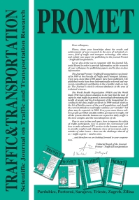
Promet-Traffic & Transportation
Innovating Solutions for Modern Mobility ChallengesPromet-Traffic & Transportation is a premier open-access journal published by SVEUCILISTE U ZAGREBU, FAKULTET PROMETNIH ZNANOSTI, dedicated to advancing the fields of traffic and transportation engineering. Since its inception in 2001, the journal has played a crucial role in disseminating innovative research and best practices within its scope, which embraces civil and structural engineering, urban studies, and various engineering disciplines. With a Q3 ranking in multiple categories as of 2023, including Civil and Structural Engineering and Ocean Engineering, Promet is positioned to provide valuable insights into contemporary challenges and solutions in transportation systems. Open-access since 2013, the journal ensures that all published articles are freely available to researchers, practitioners, and students globally, fostering a collaborative environment for knowledge exchange. Based in Croatia, it serves as an essential platform for interdisciplinary studies that influence the future of traffic and transportation policies and practices.

Frontiers in Future Transportation
Leading the Charge in Transportation ResearchFrontiers in Future Transportation, published by FRONTIERS MEDIA SA, is an influential Open Access journal that has been at the forefront of research since its inception in 2020. With an ISSN of N/A and E-ISSN 2673-5210, this journal provides a comprehensive platform for cutting-edge studies in the field of transportation, encompassing urban studies, automotive engineering, and innovative control systems. Ranking impressively in Scopus with notable percentiles—61st in Urban Studies, 51st in Automotive Engineering, and others—it underscores its significance within the scholarly community. The journal is committed to advancing the discourse surrounding sustainable and smart transportation solutions that address the challenges of future mobility. By offering unrestricted access to research, it invites contributions from researchers, professionals, and students alike, fostering collaboration and disseminating knowledge pivotal to transforming transportation systems globally. With its headquarters based in Lausanne, Switzerland, Frontiers in Future Transportation is poised to make substantial contributions to the evolving landscape of transport research through 2024 and beyond.
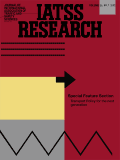
IATSS Research
Elevating engineering insights to enhance urban living.IATSS Research, published by Elsevier Science Ltd, stands as a premier open-access journal at the intersection of engineering, safety research, urban studies, and transportation. Established in 2000, this esteemed journal caters to a diverse audience of researchers, industry professionals, and students eager to delve into innovative research that addresses pressing societal challenges. With an impressive impact factor and a consistent demonstration of high-quality scholarship, IATSS Research has achieved notable rankings within Scopus, including a top-tier position in Safety Research (Rank #13/109, 88th percentile) and Engineering (Rank #46/307, 85th percentile). The journal has evolved significantly since its inception, reflecting the dynamic nature of its converged fields from 2008 to 2024. By embracing open access, IATSS Research amplifies the reach of critical findings and fosters collaboration across disciplines, making it an invaluable resource for anyone invested in advancing knowledge and practices in modern engineering and urban safety.

Communications in Transportation Research
Advancing knowledge in transportation systems.Communications in Transportation Research is a premier open access journal published by ELSEVIER, dedicated to advancing the understanding of transportation systems and their integration within the broader contexts of engineering, decision sciences, and social sciences. Launched in 2021, this journal has quickly established itself as a leading platform for innovative research, achieving impressive rankings in its categories, including Q1 status in Control and Systems Engineering, Decision Sciences, and Transportation. With its comprehensive scope, covering areas from fundamental engineering principles to applied decision-making processes, the journal attracts a diverse audience of researchers, professionals, and students eager to contribute to and learn from cutting-edge studies that shape the future of transportation. The journal’s commitment to open access ensures that valuable insights and data are freely available, fostering collaboration and knowledge sharing across the global research community.

International Journal of Intelligent Transportation Systems Research
Exploring Intelligent Solutions for Safer RoadsInternational Journal of Intelligent Transportation Systems Research, published by Springer, stands as a premier platform for disseminating cutting-edge research in intelligent transportation systems (ITS). Established in 2010, this journal has made significant strides in addressing the complexities and innovations within the realm of transportation engineering, automotive technology, control systems, and information systems, reflected in its impressive categorization across diverse engineering and applied mathematics disciplines with notable rankings in Q2 and Q3 quartiles. With a steadfast commitment to advancing knowledge and fostering discussions that bridge academia and industry, the journal welcomes high-quality research articles, reviews, and case studies that explore emerging trends, technologies, and methodologies shaping the transport sector. Researchers, professionals, and students alike will find a wealth of insights aimed at optimizing operational efficiencies and enhancing safety and sustainability in transportation networks. As of 2023, the journal continues to thrive, seeking to compile contributions that align with its mission of improving transportation systems globally.
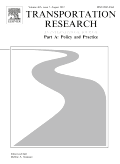
TRANSPORTATION RESEARCH PART A-POLICY AND PRACTICE
Elevating discourse on transportation policy and innovation.TRANSPORTATION RESEARCH PART A-POLICY AND PRACTICE, published by PERGAMON-ELSEVIER SCIENCE LTD, stands as a premier journal in the domain of transportation research. With a robust impact factor and a distinguished reputation, this journal is ranked in the first quartile (Q1) across multiple fields, including Aerospace Engineering, Business, Management and Accounting, Civil and Structural Engineering, Management Science and Operations Research, and Transportation. The journal's comprehensive scope invites contributions that influence policy-making and practice in transportation systems, ensuring relevance in both scholarly and practical contexts. Additionally, the journal's convergence years span from 1992 to 2024, marking a significant history of impactful research. Published in the United Kingdom, it provides a vital platform for researchers, professionals, and students seeking to advance their understanding of transportation issues globally. As an essential resource in the field, this journal facilitates the dissemination of innovative ideas and solutions that shape the future of transportation.

JOURNAL OF ADVANCED TRANSPORTATION
Exploring Solutions for Tomorrow's Mobility ChallengesJOURNAL OF ADVANCED TRANSPORTATION, published by WILEY-HINDAWI, stands as a pivotal platform in the fields of automotive engineering, computer science applications, economics, mechanical engineering, and strategy and management. With an impressive impact factor and positioned in the Q2 quartile across multiple categories as of 2023, this open-access journal offers researchers, professionals, and students unparalleled opportunities to disseminate and access cutting-edge research. Operating under an open access model since 2017, the journal fosters global collaboration and knowledge exchange, encouraging innovative solutions to contemporary transportation challenges. Its comprehensive scope, spanning converged years from 1979 to 2024, reflects its commitment to addressing the evolving landscape of transport systems worldwide. Researchers from diverse disciplines are invited to contribute transformative studies that advance the field and inspire future endeavors.

IEEE Open Journal of Intelligent Transportation Systems
Driving Innovation in Intelligent Transportation.IEEE Open Journal of Intelligent Transportation Systems, published by the IEEE-INST ELECTRICAL ELECTRONICS ENGINEERS INC, stands at the forefront of innovation in the realm of intelligent transportation systems since its inception in 2020. With its open-access format, this journal aims to disseminate groundbreaking research and technology advancements to a broader audience, fostering collaboration and knowledge exchange among professionals in the automotive, mechanical, and computer science engineering sectors. It boasts impressive Q1 rankings in Automotive Engineering, Computer Science Applications, and Mechanical Engineering as of 2023, highlighting its critical role in shaping the future of transportation technologies. The journal's exceptional standing is further evidenced by its Scopus rankings; it holds the 76th percentile in Mechanical Engineering and the 74th percentile in Automotive Engineering, making it a premier outlet for cutting-edge research. Researchers, professionals, and students seeking to navigate the evolving challenges and solutions in intelligent transportation systems will find this journal an invaluable resource.